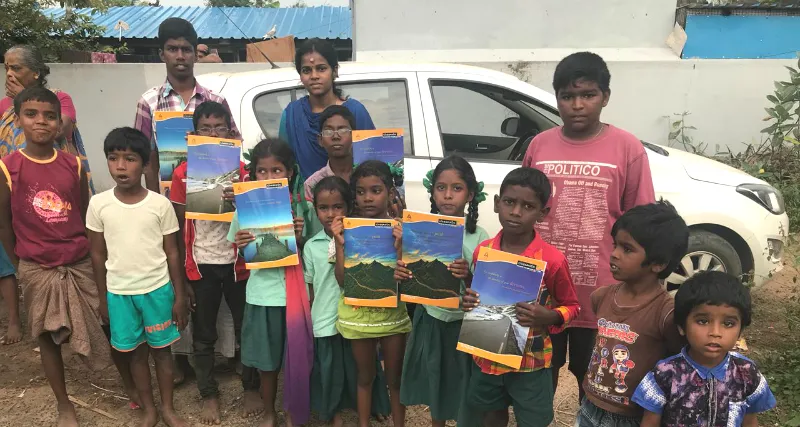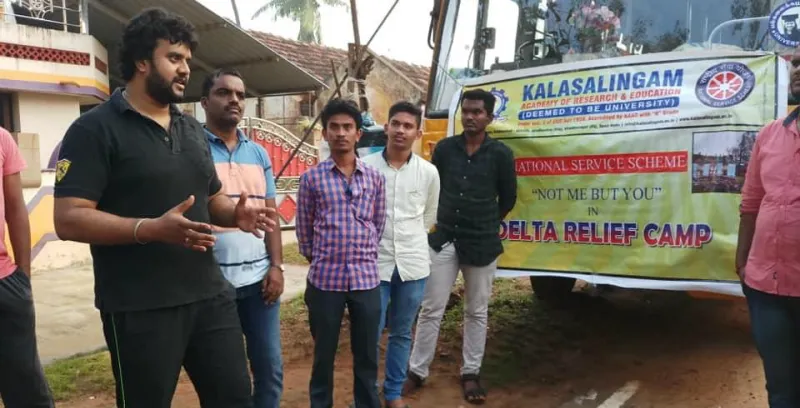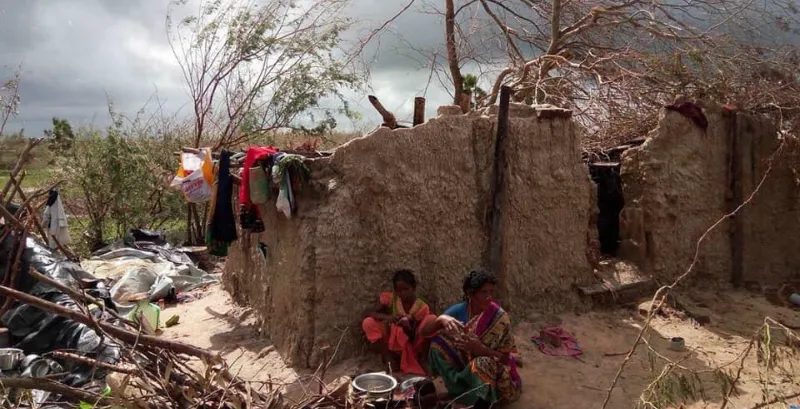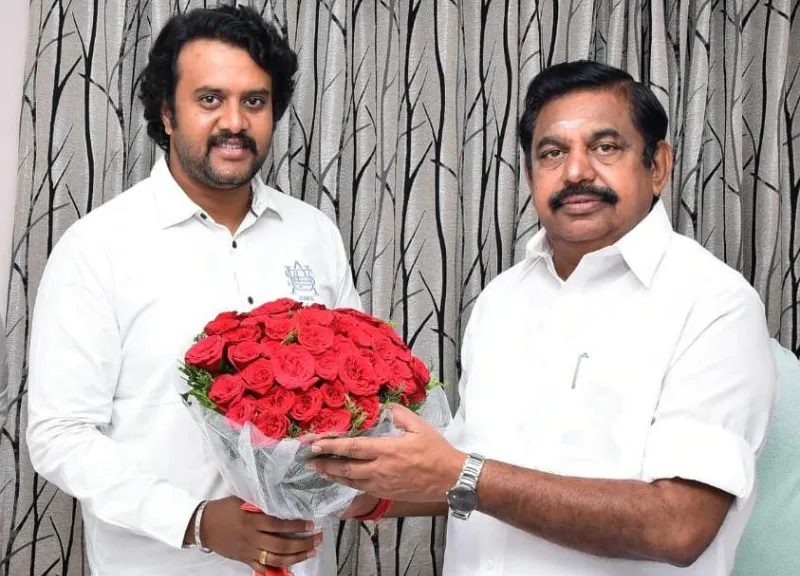How this man single-handedly led a stellar community effort to help victims of Cyclone Gaja in 117 villages
Udaya Sankar, NASSCOM Lead of Education Initiatives for South India, swung into action when he saw the devastation Cyclone Gaja had wreaked in his state. He used WhatsApp groups and roped in educational institutes to provide food and water and help rebuild houses.
When Cyclone Gaja made landfall in Vedaranyam, in coastal Tamil Nadu, on the night of November 15, 2018, it caused widespread and unprecedented damage. The severe cyclonic storm left behind a massive trail of destruction across the districts of Nagapattinam, Cuddalore, Ramanathapuram, Thanjavur, Trichy, Tiruvarur, Dindigul, and Pudukkottai, and in Puducherry. The devastation was extreme: countless homes were blown apart, trees and electric poles uprooted, roads and streets left unmotorable, and fields were in a mess. The cyclone left over 60 people dead, displaced an estimated 250,000, and led to the destruction of more than 85,000 homes.

V. Udaya Sankar, NASSCOM Lead of Education Initiatives for South India and Co-founder of Maatram Foundation, an NGO working towards providing professional education to underprivileged children, witnessed the ravage wrought by the cyclone first hand as he hails from a village near Mannargudi, one of the worst affected towns in the state. He swung into action, mobilising the community and resources to provide succour and relief – food, water, and essentials – to the affected.
Udaya learnt the magnitude of the disaster when his wife shared pictures of her parents’ farm and village with him on WhatsApp, on November 16. When he reached Mannargudi the next day, there was darkness all around.
The electricity was off, and people gathered around candlelight to speak in hushed tones about the damage to their homes, produce, cattle, and trees. There were questions in the air, and Udaya decided to help provide some answers to his villagers and the people staying around Mannargudi.
He reached out to Sai Prakash Leo Muthu, CEO of Sairam Group of Institutions, in Chennai. The Sairam group had a school in Thiruthuraipoondi, and water tankers had been pressed into service from there to provide water to affected villages as far as possible. Udaya requested Sai Prakash to supply water to his village and surrounding areas.
He was then added to a WhatsApp group created by his cousins and friends in affected areas, after which he created another group where he enlisted the help of educational institutions, including Hindustan College of Engineering, Chennai Institute of Technology, KCG College of Engineering, Sathyabama University, and St Joseph’s College (all from Chennai).

He also reached out to Kalasalingam Deemed University near Madurai, Nehru Group of Institutions in Coimbatore, SNS College in Coimbatore, and Ratnam Group of Institutions in Coimbatore. He sought help from the 10 institutes by explaining the dire situation in the Cauvery Delta region; his focus was on Nagapattinam, Thanjavur, Thiruvarur, and Pudukottai – the worst affected districts - as he had contacts there.
The next day on, Udaya’s team of volunteers, comprising friends, cousins, and others, began to supply food (prepared at a restaurant his uncle ran in Mannargudi) and water to people in disaster-affected areas. From November 18, Udaya kick-started his next plan of disaster relief.
At his request, colleges not only agreed to send relief materials but also student volunteers. His job now was to identify villages that needed the most help and support. With truckloads and containers of relief materials making their way to Mannargudi, he and his team focused on supplying food, water, and essentials such as a mat, mosquito coils, candles, and supplies that would last for two days.
Fixing the damage in other villages
Relief work was on, but the rest of the world was still unaware of what was happening in Tamil Nadu. Power was still out and cell phone towers were not functioning. Udaya, with some of his team members, decided to travel some 20 km to share the news with the outside world, via WhatsApp. It was six days after Gaja made landfall that the mainstream media began covering the on-ground situation in the worst-affected areas.
On Day 5, a group of 16 doctors reached Mannargudi bus stand but were clueless on how to proceed. Udaya’s team directed them to villages where they checked the affected people for illness and small ailments. “All the people wanted was someone to speak to about their ailments and problems,” Udaya says.
As Udaya travelled to other villages with his team, he was able to witness the widespread damage to houses, other property, cattle, trees, and fields.

“The wind’s fury had ravaged everything in its path. Only 20 percent of the houses would have survived this cyclone in my estimate,” he told YourStory in an exclusive chat about his relief efforts.
By then, as many as 67 educational institutes across Tamil Nadu were supplying relief materials to Udaya’s team on a daily basis. Udaya also began to tweet about the situation with photographs. A retweet from his friend and Tamil actor, Vijay Sethupathi, went viral and led more film personalities to contribute to the effort. “We were careful not to get any money. We requested everyone to only to send relief materials,” he recalls.
Actors Sivakarthikeyan, Keerthi Suresh, Aishwarya Rajesh, lyricist Vivek, and composer Santhosh Narayanan, all of whom he counts as friends, were part of the contributing effort.
Contributions continued to pour in. According to Udaya, he and his team diverted the relief measures and materials to 117 villages in a month’s time.
It was after Chennai Memes, an online destination for current happenings in South India, put up a meme on him, that the NASSCOM HR team realised what Udaya was doing. NASSCOM President Debajani Ghosh lauded his efforts and offered immediate help through NASSCOM Foundation and member companies. She personally contributed to providing food for a week to villagers in affected areas.
After a while, attention turned from immediate necessities to long-term worries. The roofs of most houses had been blown away, and Sri Krishna Group of Institutions, in Coimbatore, came up with 500 tarpaulins. Plastic covers were put on some roofs. Vel Mohan, of Chennai-based Velammal Institutions, sent 50 men with cash whose task was this for five days: stopping relief vehicles, asking about their fuel status, and giving cash for 50 percent of fuel requirements.

Coimbatore-based Kumaraguru Institutions went a step further when its Chairman, Shankar Vanavarayar, sent fine arts and civil engineering students to help rebuild schools in the region.
“We focused on schools as my friends told me that children’s happiness helps bring a family back to normal,” Udaya explains. Of the 17 government schools identified for rebuilding, 13 schools have been repaired - damaged classrooms have been reconstructed, the walls have been painted, and chairs, tables, and fans put in place. The fine arts students decided to leave behind an artistic, colourful touch – paintings on the walls.
Turning a corner
Udaya says that what he saw in the villages was heartening. Despite their difficult circumstances, the villagers refused relief material if they had sufficient quantities, asking him and his team to focus on areas that needed them most. Caste divisions disappeared and political affiliations were kept aside as villagers and volunteers rose to the occasion to provide relief to affected areas. Municipal and electricity department workers went beyond their call of duty, working almost ceaselessly to restore amenities and electric supply.
“Our team’s relief measures would have touched 50,000 people,” Udaya says. Although Udaya left for Chennai after 13 days, his team continued to supply affecting villages with relief materials, including food and water, till January 1, 2019.
Udaya has come in for praise from all quarters for his efforts. He was felicitated at an event and received an award from state ministers Dr Nilofer Kafeel and K “Ma Foi” Pandiarajan. The high point was when Chief Minister of Tamil Nadu, Edappadi Palanisamy, invited him for a breakfast on December 13, 2018, and felicitated him for his remarkable contribution to alleviate the suffering of affected people.
“Although my work pressure is forcing me to stay away from relief work for now, I am talking about it to several people,” Udaya says. He credits NASSCOM for allowing him to make a meaningful contribution to society. He was invited to Uzbekistan and Dubai for talks so that funds could be mobilised from the local community there. He has pointed people willing to help to NGOs. “If I get involved in that work, my own job will suffer,” he says.
Udaya may be back to work, but he’s not done with volunteering yet. “A lot more remains to be done,” he says, adding that offers to adopt villages have already come in from founders and chairmen of some big educational institutes. He is hopeful that the state government’s relief, which will be provided after a complete survey, will provide people with an opportunity of livelihood and recovery. “It’s not my individual effort, but the teamwork of 300 people,” he says, on his efforts to help.






